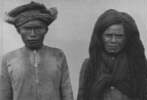| CONTENTS: Introduction
|
INTRODUCTION One of the unique characteristic of the Lore Tribe in the Bada Valley is their tradition of making cloth from the bark of trees. This material is called "Ranta". In Napu Lore Utara "Ranta" is called "Hampi", in Kulawi is called "Mbesa", and in Pamona "Inodo". Bark cloth is still a common material used by the people of Bada to make the following types of clothing:
Bark cloth or "Ranta" is also called "Fuya". This name originated from the period of Japanese Occupation of Indonesia during the 1940's. During this period cloths was very difficult to obtain. The materials that normaly came from Holland and England were in limited supply because of the war and the difficulties of transportation. To supply for this shortage of Japanese instructed the people of Bada to produce the traditional barkcloth or "Ranta". Over period of 3 years, 14 villages in Bada produced thousands of meters of cloth. This cloth then was taken to Poso by men or horse. Barkcloth is not a very strong material and easily torn when wet, but if it's properly taken of it can last for over 100 years. To care for bark cloth it should be soaked in "Molimbe" water, a mixture of several different types of bark taken from the "Hiuri", "Wone Pakana", "Bolaa" and "Kaika" trees. This mixture is beaten until soft and then boiled. After soaking the barkcloth in this mixture, it is then laid out in the sun to dry. This process makes the cloth hard, clean and shiny. It is not any tree that can be used to make barkcloth, most commonly it is made from the banyan tree, or "Nunu", as it is locally called. There are several species of "Nunu" that are most often used, these are "Nunu Bea", "Nunu Lamba", "Nunu Lendkori", and "Nunu Malo". The bark of these trees used to make barkcloth. Other trees used to make barckcloth are "Bea-ebe" tree commonly found in around the garden, or the "Walabea" tree. The later, which is found in the forest is also used locally to make rope. Both these trees produce a white barkcloth. THE TOOLS There are several different tools used in the process of making barkcloth. These are described below.
MAKING BARKCLOTH The first step is to obtain a branch from the trees that are used to make barkcloth. A brach is ready to be used when the leaves has begun to turn dark green from their "white yellowish" color characteristic of the young leaves. At this stage in the tree's growth the fiber is smooth and the bark can be easily removed from the tree. Once the bark is removed from the tree the outside skin is peeled off. The smooth innerside of the bark is then cleaned to remove the liquid. It is then rolled up, tied and boiled for several hours until the threads of the bark become finer. To rid the cloth of the sticky liquid from the boiling process it is cleaned with water. The fibers are then wrapped carefully in banana leaves where they are stored for about 4 to 7 days during which time of process the fermentation takes place. The fermentation process is called "Mobakawai". The next step is the "Mopepe" process which involves pounding the bark with a "peboba". The next process to make the material smoother, thinner and larger is called "Moboba". Before starting this process, the cloth to make it an even thickness is cut into two pieces, with one pieces being placed on top to the other. It is then beaten using the "ike pehelai". This process is called "Mohelai". After the "Mohelai" process is completed, the cloth is beaten with the "ike pehelai" using both hands in a fast motion. Comparatively, if the clothes is beaten slowly using both hand interchangedly, it is not called "Moboba", but "Mopede". To strech out the bark the beating process is continued using the "Ike Pepengka" this process is called "Mokero". The final step in beating process is called "Mopaupu" or "Mopakaroa". During this process the cloth is beaten with the "Ike Pepaupu". This process is also referred to as "Pepakaro'a" which means putting on the finish touch. During the process of "Mopepe", "Moboba" and "Mohelai", the barkcloth is rolled over the "Popedea". A stick cloth called a "Tande" or "Lata" is used to manipulate the barkcloth during these processes. When the "Ike Pekero" is already outside of the barkcloth and the "Tande" is no longer used to roll the bark, the process is then called "Mopede". In order to keep the barkcloth moist during this stages of "Mopepe", "Moboba", and "Mohelai", a broom made from the rice straw. A "Pehai" is used to springkle water over the cloth. This process is called "Pehiwu". When the beating process is completed the barkcloth is placed in the sun to dry. After the cloth is dried it is dyed using "Molimbi" or "Motumba" as described above. The next step involves two people in the process of streching and pulling the the bark by hand to make it smooth. The final step is the pressing of the cloth, this is called "Motuki". (This translation appears courtesy of The Nature Conservancy (TNC), Palu Office and the orginal author, Tedai Toia of Bewa, Lore Selatan. Copyright remains with the author and TNC Palu office, 1995. Please contact the TNC office above for further information.) |
|||
| Painted barkcloth designs from the Besoa and Bada Valleys | ||||
| copyright 1999 by D. Fournier. Please contact me at [email protected] to copy information found here or to share something about Central Sulawesi. |
||||

